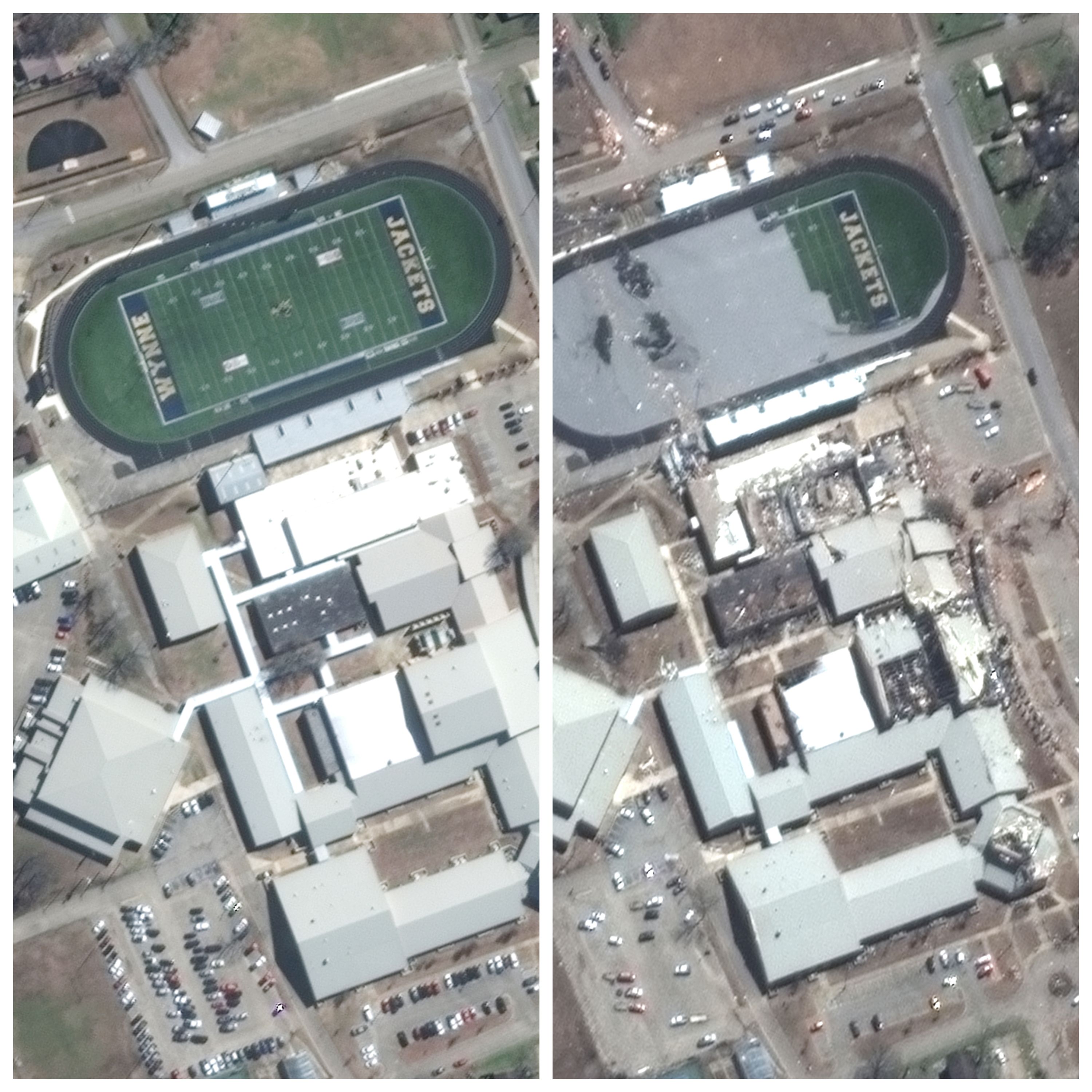More than 50 people are dead after severe thunderstorms and tornadoes tore through the U.S. South, Midwest and Mid-Atlantic in the past two weeks — and another potentially significant outbreak is projected for Tuesday.
The big picture: At least 32 deaths have been confirmed from the latest powerful storm system, which brought over 50 preliminary tornado reports including in Alabama, Delaware, Illinois, Indiana, Iowa, Mississippi, Tennessee, New Jersey and Arkansas — where President Biden expedited "a major disaster declaration" to provide federal assistance to the Natural State.
Meanwhile, the National Weather Service's Storm Prediction Center (SPC) warns there's an "enhanced risk" that severe thunderstorms will develop on Tuesday from Illinois southward to Arkansas.
- "These could pose a risk for a few strong tornadoes, large hail and damaging wind gusts," the SPC said in a forecast discussion Sunday night.

"Tornado alley" moving
The intrigue: Tornadoes and tornado outbreaks are an area of active investigation for climate scientists.
- Victor Gensini, a meteorology professor at Northern Illinois University, told Axios in a phone interview Sunday that while research on the role of human-caused climate change in altering tornado characteristics is still in its infancy, records dating back over 70 years indicate a shift eastward from the traditional areas of the Midwest known as "tornado alley."
- "Texas, Oklahoma, Kansas, Nebraska, those kinds of areas are typically staying stagnant or decreasing in terms of the number of strong tornadoes they get every year," Gensini said.
- "But then you see an increase in places like Tennessee, Mississippi, Alabama, Illinois, Indiana, areas that are the traditional area of the Great Plains," he said. "And that's incredibly important for the United States — as you go from the Great Plains, the population density rapidly increases."
Yes, but: Harold Brooks, a senior research scientist at the National Severe Storms Laboratory in Norman (Okla.), who coauthored a study on tornadoes with Gensini, cautioned in a phone interview with Axios Sunday night that tornadoes are small-scale phenomena, occurring within thunderstorms that are themselves small in scale.
- This makes it difficult for researchers to decipher how climate change factors in with precision, Brooks noted.
Warming alters severe thunderstorm ingredients
What's happening: Jeff Trapp, head of atmospheric sciences at the University of Illinois, said data suggests climate change is already altering one key ingredient in severe thunderstorm formation, a quantity known as "CAPE" (convective available potential energy).
- This metric helps to indicate how much atmospheric energy there is for thunderstorms to tap into, once they are triggered by a cold front or other mechanism.
- Higher CAPE indices are now more likely to be "found outside of the traditional tornado season of late spring/early summer," Trapp said via email.
Zoom out: Studies show that while some severe thunderstorm ingredients, such as humidity and atmospheric instability, are likely to increase with a warming climate, others may do the opposite.
- Climate change is anticipated to decrease the amount of wind shear available to severe thunderstorms, which could deprive them of a key ingredient for tornado formation.
Tornado season shift
- Trapp said that overall, the frequency of tornado activity in the U.S. has been declining, but the peak occurrence has shifted to earlier in the spring.
- "This shift is due in part to late winter/early spring tornadoes such as what we’ve seen this year," Trapp added. "An increase in these 'out-of-season' events is consistent with climate model projections."
What we're watching: Brooks said in an email the decadal average number of tornadoes may very well stay the same, but we could see more big years and small years.
- "There's some evidence we're seeing that with a lot of monthly records for numbers, both high and low, in the more recent years," he said.
- "We also have expectations that the number of severe thunderstorms (hail, wind, tornado) will probably increase in the U.S. (with increased variability on top of it), but the tornado question is not as clear."
Climate change impacts
The bottom line: We can't yet connect an individual tornado's ferocity or occurrence to climate change, but the overall environment in which they occur is already being altered by increased amounts of greenhouse gases.
- Brooks noted in his phone interview that while changes in occurrence in tornado-effected regions was about 10%, the threat was much higher due to increasing population densities and impacts on poorer communities.
- "It's really two things that are happening: climate change is altering the frequency, the intensity, maybe the location of where these things are happening, but at the same time, humans are increasing our footprint, our cities are growing larger" and this needs to be factored into for urban planning, per Gensini.







